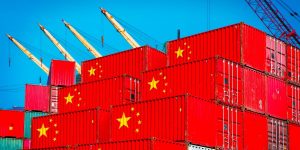China-OBOR Multilateral Trade Increases 26%
 Trade in goods and services between China and the various countries making up the One Belt, One Road has increased by 26.2% in the first quarter of 2017 to USD240 billion, according to the Chinese Ministry of Commerce. Sun Jiwen, a spokesman for MOFCOM, said that China’s exports to 60 identified OBOR nations from the Western Pacific to the Baltic Sea increased 15.8% year-on-year to RMB937 billion (US$135 billion), accounting for 28.2% of China’s total exports. Imports to China from these countries were also up, reaching RMB717 billion (US$104 billion), a 42.9% increase compared with the same period in 2016, and accounting for 25% of China’s total imports.
Trade in goods and services between China and the various countries making up the One Belt, One Road has increased by 26.2% in the first quarter of 2017 to USD240 billion, according to the Chinese Ministry of Commerce. Sun Jiwen, a spokesman for MOFCOM, said that China’s exports to 60 identified OBOR nations from the Western Pacific to the Baltic Sea increased 15.8% year-on-year to RMB937 billion (US$135 billion), accounting for 28.2% of China’s total exports. Imports to China from these countries were also up, reaching RMB717 billion (US$104 billion), a 42.9% increase compared with the same period in 2016, and accounting for 25% of China’s total imports.
| Trade Corridor | USD (billions) | % Increase on Q1 2016 |
|---|---|---|
| OBOR Exports to China | 104 | 42.9 |
| China Exports to OBOR | 135 | 28.2 |
| Trade Balance in China’s Favor: | 29 | – |
“I’ve pointed out several times that the bulk of China’s sought-after outbound investment is actually going into Silk Road regions” says Chris Devonshire-Ellis of Dezan Shira & Associates, and these trade figures absolutely show that this is accompanied by significant increases in trade.”
Related Reading: Eurasian Economic Union Trade Up 38%
The increase in trade is significant and possibly demonstrates that their is also a huge political will to encourage and develop trade along the OBOR region. The trade imbalance is not huge, suggesting China is also actively encouraging imports specifically from OBOR nations. This is borne out by MOFCOM’s China outsourcing statistics, which show that China signed contracts worth RMB26 billion (US$3.7 billion) with One Belt One Road countries during Q1, with RMB16.4 billion (US$2.3 billion) already completed, up 33.9% and 18% on the same period in 2016 respectively. Outsourcing contracts with ASEAN nations hit RMB17 billion (US$2.4 billion) with RMB10 billion (US$1.45 billion) completed, increasing 49.4% and 27.8% respectively. These appear to indicate a shift in prioritizing Chinese purchases to fit into the OBOR overland and maritime route strategy to ensure it is a political success.
China has also made non-financial direct investments valued at US$2.95 billion along the OBOR routes during Q1, accounting for 14.4% of the national total. 781 Chinese companies were established in the same period in OBOR countries, up 40% year-on-year, with total investments worth RMB8.45 billion (US$1.23 billion).
“These figures show that the global supply chain is shifting” says Devonshire-Ellis “With preferred suppliers coming in part from the OBOR nations. With China currently negotiating an FTA with the Eurasian Economic Union, businesses wishing to continue to supply China need to factor in additional competition from new OBOR based suppliers, or better engage with China’s OBOR strategy in order to maintain a trade advantage”
About Us
Silk Road Briefing is published by Asia Briefing, a subsidiary of Dezan Shira & Associates. We produce material for foreign investors throughout Eurasia, including ASEAN, China, India, Indonesia, Russia & Vietnam. For editorial matters please contact us here and for a complimentary subscription to our products, please click here.
Dezan Shira & Associates provide business intelligence, due diligence, legal, tax and advisory services throughout the Asian and Eurasian region. We maintain offices throughout China, South-East Asia, India and Russia. For assistance with OBOR issues or investments into any of the featured countries, please contact us at silkroad@dezshira.com or visit us at www.dezshira.com
Related Reading:
China & Russia Propose Vast New Eurasian Free Trade Zone
Russia Looks To Link Eurasian Economic Union With OBOR
Silk Road and OBOR Business Intelligence
Dezan Shira & Associates´ Silk Road and OBOR investment brochure offers an introduction to the region and an overview of the services provided by the firm. It is Dezan Shira´s mission to guide investors through the Silk Road´s complex regulatory environment and assist with all aspects of establishing, maintaining and growing business operations in the region.






